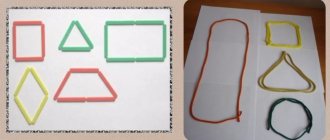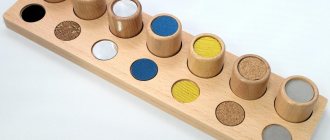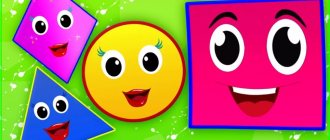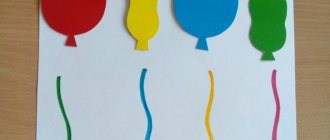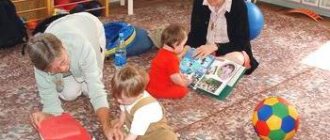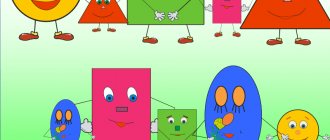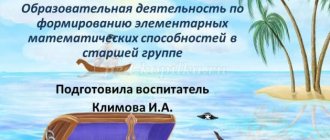Summary of GCD in the senior group. Spatial relationships: left, right
Summary of educational activities in the senior group.
Author: Irina Ivanovna Shishkovskaya, teacher of the senior group of compensatory orientation of the MBDOU “TsRR-d/s “Chaika”, Abakan. Description of the material: this material is intended for children of senior preschool age. It will be interesting and useful for preschool teachers in the field of Cognitive development. The summary was compiled taking into account the Federal State Educational Standard. Topic: Spatial relationships: left, right. Goal: Creating conditions for the formation of spatial relationships: right, left. Objectives: 1.Create conditions for the formation of spatial relationships: left, right and the development of spatial representations. 2. Provide conditions for the development of children’s search activity. 3. Create conditions for children to make their own decisions and show initiative and independence. 4. Create conditions for children to express their thoughts and to encourage children to engage in speech activity. 5. Promote the development of skills for constructive interaction between children and peers. Organization of children's activities: 1. communication between a child and an adult; 2. communication of the child with peers; 3. research activities. Preliminary work: learning finger gymnastics “Clap, palm” and physical education with children; reading N. Nosov’s book “The Adventures of Dunno and His Friends”; acquaintance with the images of “Why” and “Dunno”. Equipment and materials: magnetic board with magnets; pictures: Pochemuchka, Dunno, fork in the road, birch, fox, wolf, bear, hare, deer, squirrel, wild boar, badger, beaver; travel route map; jars with a mixture of dirt and water, bottles with cloudy liquid; chalk; icons for the Pochemuchek and Dunno teams; 2 drawings of city streets; 2 drawings of a five-story building; 2 sets of numbers 1-10; drawings-riddles according to the number of children; colored pencils, wax crayons, felt-tip pens. The course of direct educational activities. Introductory part. Children are included in the group. On the board hangs a poster with a picture of two friends: Pochemuchka and Dunno, who are standing at a fork in the road. The adult does not pay attention to the board. Children discover the poster on their own, gather around the board, and turn to an adult with questions. Educator: - Who do you think is depicted on the poster? -Why are Dunno and Pochemuchka so thoughtful? (Children’s assumptions.) Educator: -Pochemuchka and Dunno were standing at a fork in the road. No one could understand where is right and where is left. But suddenly Dunno scratched his head with the same hand with which he wrote, flipped through the pages and held the map. -How can I get home? - a cry was heard: Where is the right, where is the left - none of them knew. The children carefully examine the poster and notice some kind of paper in Dunno’s hand and express their assumptions. Educator: - Indeed, this is a map. Do you know where is right and where is left? Let's check it out. Game exercise (finger gymnastics) “Clap, palm” Children stand in pairs facing each other. They recite a poem and at the same time perform the movements: Here is our game: Clap, palm, Clap, another. Right palm and then clap louder with your left palm. And then, then, then the left one will beat the right one. Educator: -How can you help your friends? Children's guesses. Children express their own feelings, construct a complete answer, and build a logical chain. Educator: -Friends got lost on their way to visit their animal friends in a forest clearing. To help them meet and return home, and most importantly, not get lost in an unfamiliar area, we will use a map. -We need to make a few stops. -What will we take on the journey so that our friends can get home quickly? -What is the fastest passenger transport? Children's guesses. Planning stages of activity. Educator: - Let's hit the road. Physical education Hands to the sides - take flight We send the plane: Right wing forward, Left wing forward Our plane flew. Main part A painting depicting a clearing with a birch tree in the center. Cards with pictures of animals. 1st stop “In a forest clearing” Educator: -Adult animals, mothers and fathers, went into the forest for food, and left their cubs in the clearing. -Which cubs are left in the clearing? For a fox - (little fox) For a bear - (little bear) For a hare - (little hare) For a deer - (fawn) For a squirrel - (little squirrel) For a beaver - (little beaver) For a wolf - (little wolf) For a wild boar - (little hog) For a badger - (badger) Children name the cubs and, through free choice and the ability to agree, sort out cards with images of animals, on the back of which signs of their location are inscribed. Educator: -When leaving, the parents asked their children to wait for them near the birch tree, which stood in the center of the clearing. -Now, each of you will turn into artists, and together we will create a picture (each team receives pictures with identifying signs on the back) Little fox to the right of the birch, Little bear to the left of the birch, Little boar under the tree, Little squirrel on the tree, Little hare in front tree, Fawn to the right of the little fox, Little Wolf to the left of the bear cub, Little Beaver next to the little hare, Little Badger behind the little fox. Children arrange the animals in the stated order around the birch tree using magnets and a magnetic board. Educator: -We visited friends Pochemuchka and Dunno and flew on. Physical education Hands to the sides - take flight We send the plane: Right wing forward, Left wing forward Our plane flew. Educator: 2nd stop “Swamp” -We landed near the city where our friends live. But it seems we can’t get through here... The children examine the soil, sample the water, and conclude that in front of them is a swamp. On the way to the city there is a swamp, in order to get through it, we all need to go together “trace after trace.” We will go to the right - 1,2,3. And now to the left - 1,2,3. And again to the left - 1,2,3. Again everything to the left - 1,2,3. Children move along a path drawn in chalk. Stop 3 “City” Educator: -The swamp was behind us, and we found ourselves in the city. -But how can you find, among many houses, houses where friends live? - It is known that on the same street as Dunno and Pochemuchka, new houses were built for the numbers, so that they could all live together in harmony, and they would not be bored. Let's find Pochemuchka's neighbors and Dunno's neighbors. An adult suggests dividing into teams. Children suggest ways to divide into 2 teams, those who help Pochemuchka and those who help Dunno. For each team, a 5-story house with two windows on each floor is drawn. Numbers are distributed, on the back of which are the letters L (left) and P (right), and the floor number. It is necessary to “distribute” the numbers among the window apartments. Educator: - From the neighbors, we learned that Pochemuchka lives in the tallest building on the fifth floor, in the apartment on the left, and Dunno lives in the lowest building, on the fourth floor, in the apartment on the right. Help me find their windows. (Drawings of city streets) Educator: -Friends were so happy to return home that they asked their friend Tubik to give you drawings - riddles that need to be completed and turned into pictures from our trip. Each child decides for himself what he will use to draw. To do this, there are colored pencils, wax pencils, and felt-tip pens on the table. The task is performed to the song “If you went on a journey with a friend.” Final part Educator: - Guys, did you like our trip? What good deeds have you done and who have you helped? Did we manage to accomplish what we planned? What helped us with this? Statements and conclusions of children.
We recommend watching:
Math holiday in kindergarten. Senior group Game manual on FEMP for children of the senior preparatory group of kindergarten Synopsis of an elective in the senior group. Entertaining mathematics for preschoolers Summary of GCD in mathematics in the senior group. Journey through a fairy tale
Similar articles:
Notes for mathematics classes in the senior group
Summary of a lesson on FEMP in the senior group of a preschool educational institution. Topic: Orientation in space
Summary of a math lesson in the senior group on the topic: New Year
Summary of a lesson on FEMP in the senior group of a preschool educational institution. Topic: “Composition of a number of units (number 7)”
Planning for FEMP in the senior group according to Pomoraeva
Development of orientation in older preschoolers using diagrams
In children aged 6 to 7 years, the development of spatial concepts is expanded using the modeling method. This method can be used in different forms, but the most relevant are diagrams.
When figuring out how to get to the final point, a preschooler feels like a traveler, a treasure hunter or a rescuer. For example,
- "Find the treasure." There is a “treasure” (a box of treats) hidden in the room. The child is offered play motivation: “You are a traveler looking for treasure. The card shows a diagram that will help you find it. Hold the card in front of you, look in which direction the arrows are pointing, and follow them. Be careful".
- “Help Masha find her way home.” Instructions: “Draw Masha’s path on a piece of paper, starting from the arrow to the house shown: one cell up, two to the left, two up, one to the right, one down, one to the right, two up, etc.” This task is based on graphic dictation.
- Make a schematic plan of your room (kitchen, playroom in kindergarten, etc.), marking pieces of furniture with squares and circles.
Graphic labyrinths provide effective assistance in developing a child’s orientation and spatial thinking skills.
After the child has found the right path through the maze (in this picture you need to help the mouse get to the apple), it is important to invite him to describe the route with the words: “Walk straight along the path, turn left, step onto the next path and turn left again, etc. "
At the first stages, the help of an adult is necessary, since the preschooler must understand the algorithm for determining the route using a diagram or sketch of a plan. Subsequently, there is enough control when performing the task.
It should be noted that preschoolers are interested in learning spatial orientation. This is a natural need, and the child unconsciously feels that he is expanding his own boundaries when he understands more about the organization of space. All he needs is a little help from an adult.
Target: strengthen children’s ability to navigate the space of the playroom and on a sheet of paper; exercise children in reading diagrams of the arrangement of objects in a limited space; improve the ability to move in a given direction; develop voluntary attention, memory, fine motor skills.Progress of the lesson
Presenter (V.). Guys, do you like to travel? Me too. Let us go on a journey through our group today and perhaps we will be able to see something new, interesting in ordinary objects, and maybe we will find new friends.
Updating knowledge about modes of transport.
Let's remember what you can travel on? What type of transport do you like best? Let's choose a train. What parts does the train consist of? (Locomotive and carriages.) Who wants to be a locomotive? Who can drive our train best?
Game "Shadow Domino".
Q. To build a train, everyone must take one domino card and build a chain by placing a colored image of an object on its shadow. Now, guys, stand behind each other in the same order as your cards are. Tell me who is behind whom. Remember your seats and you can go your separate ways. So we have a train. Now we need to choose our route. What does that require? (Map.)
Reading a diagram (repetition of graphic symbols).
B. For this we will use the game room plan that we drew up in the last lesson. Let's imagine that we have just joined the group. What's to your left? (Windows.) What color are the windows on our plan? (Blue.) What is in front of the windows? (Table.) What shape is it? (Rectangular.) What color is the table top? (White.) Show where this table is marked on our plan. What's to your right? (Drawing tables.) How many are there? (Three.) Are they the same? (No, there’s a big one in the middle and small ones on the sides.) What shape is the big table? (Trapezoid.) What color is it? (White.) What shape are small tables? (Square.) What color are they? (Yellow.) Show where they are located on our plan. What is located in the middle of our plan? (Carpet.) What color is it indicated? (Red.)
What is shown on our plan in the upper right corner? (Theater corner.) Guys, on the plan arrows indicate our route and stops where amazing adventures await us. Where does our journey begin? (From the door.) Do you remember who stood behind whom? So, let's go!
Game "Train" (movement according to a pattern in a given direction).
Children receive a map in their hands and follow the arrows to the first stop indicated on the diagram. The train stops, the cars randomly scatter.
Q. Guys, who is sitting in Pavlik’s place? (Monkey.) Look at it. What kind of fur does she have? (Fluffy, brown, smooth, warm, soft, etc.) What sad eyes she has! I understood why she was so sad: she has no home. Guys, can we help the monkey? How? (Let's build a house.) But to build a house, you need to draw a drawing.
Orientation on a sheet of paper (verbal dictation).
B. Take the leaves and arrange them so that the red stripe is to your left. Grab your pens and get ready. From the point, draw a line 5 cells down, 5 cells to the right, 5 cells up, etc. (Children complete the task.)
Well done! What beautiful houses you have created! Now the monkey can build himself a house. And our journey continues.
A task to change the direction of movement according to verbal instructions.
B. Walk forward to the carpet, turn left. Go to the corner of the carpet and turn right. Walk forward to the next corner of the carpet and walk forward 3 more steps. (Second stop.)
Guys, where have we arrived? (To the theater corner.) Who lives here? (Fairy-tale heroes.) That's right, this is Cheburashka - a fairy-tale character. But he's also sad. He has a house, but no carpet for playing. Can we help him? (Yes, we will give him a carpet.)
Orientation on a sheet of paper (creating an applique).
Q. What shape is our leaf? (Square.) Roma, put a yellow square in the middle of the carpet. Katya, put an oval on top in the middle, a second oval on the bottom, etc. Glue triangles in the corners of the carpet. How many triangles do you need? (Four.) What color are they? (Blue.) Glue circles between the ovals. Did we do it well? What a colorful carpet! Cheburashka liked him, so he will sing us a song, and let us follow him with our eyes.
Gymnastics for the eyes, relieving visual tension (using a sounding toy).
Q. Guys, where did our plan go? And what is this letter? (They read the letter.) Yes, this is a letter from a mole. He invites you to play hide and seek. He hid himself and left only a hint letter. Do you know who the mole is? What does he look like? Where could he be hiding? Let's look.
Game “Find the toy” (a diagram of the play corner or verbal instructions are offered). (Children complete the task.)
Q. Where was the mole hiding? Let's play hide and seek together. Where is the mole hiding? (On the table, under the table, behind the closet, in the closet, etc.)
The mole told me where our map is, it's under the blue box. Bring it, please. But this is not a map, these are images of dancing men. Let's dance to the music too.
Physical education lesson (children perform exercises based on visual symbols).
V. It’s time for us to hit the road! Steam locomotive, give the signal to depart! We are heading to the last stop.
Game "Labyrinth".
Q. Guys, the animals lost their cubs in the labyrinths. What to do? (We will take them to their mother.) Then sort out the cards and help the cubs. (Children complete the task.)
Well, our journey has come to an end. Where have we been today? Who did you meet? Did you enjoy the trip? Thank you for your attention!
